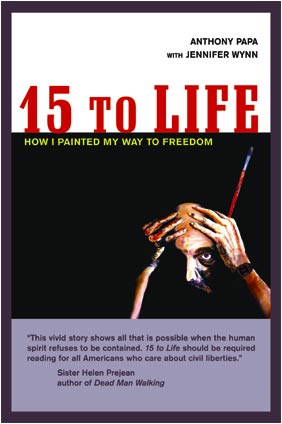DRCNet
Book
Review:
"15
To
Life:
How
I
Painted
My
Way
to
Freedom,"
by
Tony
Papa
with
Jennifer
Wynn
Feral
House
Press,
$22.95
HB)
10/22/04
Some 17,000 people -- the vast majority black or Latino -- are currently serving decades-long mandatory minimum prison sentences in New York state, the legacy of liberal Republican Gov. Nelson Rockefeller's pioneering effort to suppress drug use by imposing draconian penalties on even low-level drug offenders. When the governor pushed through what are now known as the Rockefeller drug laws -- how's that for a legacy? -- in the early 1970s, he began the push toward mandatory minimum sentencing that swept the country in the years since then. Gov. Rockefeller deserves a large share of the credit, if that is the right word, for beginning the trend that has resulted in the United States -- the land of the free -- becoming the most imprisonment-happy country in the world. Anthony Papa (http://www.15yearstolife.com) is one of the victims of the Rockefeller drug laws. As a young married working man in New York City, Papa knew nothing of the severe penalties awaiting those who violated the Rockefeller laws. Short on money after a string of losses gambling on bowling, Papa agreed to deliver a package for one of his bowling alley buddies. It was supposed to have been an easy $500; instead, it was the beginning of Papa's extended sojourn in the Dante-esque world of the New York criminal justice and correctional system.
"15 To Life" is the story of Papa's journey to hell, his desperate fight to regain his freedom, and the continuing effort to repeal the Rockefeller laws and win justice for the thousands of drug offenders still rotting away inside Attica, Clinton, Sing Sing, and all those other places whose names are now synonymous with infamy. With assistance from Jennifer Wynn, Papa treats the reader to a horrible, gripping narrative account of his odyssey in the New York criminal justice system. (After finishing Papa's book, I feel a strong urge to never write that phrase without using quotation marks around the word "justice.") Prisons have high walls not just to keep the prisoners in but also to keep public knowledge out. As Papa so eloquently reiterates, they are brutal places. They are filled with sadists, thugs, and thieves -- and that's just the guards. The administration of New York's prisons that Papa writes about can only be described as institutional sadism: The guards ominously slapping their batons as new prisoners arrive, the prison goon squads clad in riot gear who so bravely beat the crap out of inmates who dare to protest their mistreatment, and the less violent but equally crazy-making arbitrary infractions handed out by guards on a whim. And we have the nerve to wonder why people come out of prison worse than when they went in? Sadism and savagery are not, of course, limited to the prison guards. By treating drug offenders as dangerous criminals worthy of decades-long prison sentences, New York in essence throws to the wolves thousands of nonviolent drug offenders. With those long sentences, they are sent to prisons like Attica and Sing Sing that are the home to truly hardened criminals. Clueless dopers become easy prey for the violent men who flourish in prison society. Papa himself relates at least two incidents where he was attacked by other prisoners, one mentally disturbed, the other just plain mean. Tony Papa was able to paint his way out of prison, and much of "15 To Life" tells the story of how, thanks to inmate mentors, he discovered his talent and was able to produce images so harrowing and horrid that he was able to break through the walls of silence, make allies on the outside, and eventually win his freedom. But Papa was the exception; the governors of New York rarely grant clemency, and thousands upon thousands of other Tony Papas are rotting away behind the walls as you read these words. Since his release, Papa has been very active in the movement to win freedom for the rest. The final chapters of "15 To Life" are the latest notes on a work in progress: the years-long effort to repeal the Rockefeller drug laws. Papa recounts his frustrations in dealing with politicians who acknowledge the cruelty, inhumanity, and uselessness of the Rockefeller laws, but refuse to change them because of political calculations, and his realization that it would only be with an uprising from the bottom that those laws would be changed. Now, in late 2004, the Rockefeller laws are still in place, but Papa has helped craft a movement that threatens to strike them down. The final chapters of "15 To Life" have yet to be written. "15 To Life" is a searing indictment of the New York criminal justice system, and by extension the entire law enforcement approach to drug use in this country. But it is an indictment that reads like a page-turner of a novel. This harrowing, first-person account of crime and injustice, imprisonment and redemption, is a guaranteed eye-opener for anyone who wonders about whether our current approach to drugs is the correct one. And more broadly, it is a screaming indictment of a prison culture in this country that threatens to rob the soul of America. Read it. Read it and hope that we can find a better way. But read it and weep for the hundreds of thousands of Americans deprived of their liberty and locked up in brutality factories. And read it and weep for all us. Thomas Jefferson once famously observed, "When I consider that God is just, I fear for my country." After reading "15 To Life," all I can say is, "Me, too."
|

